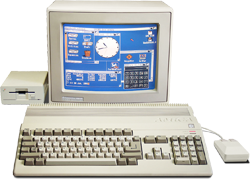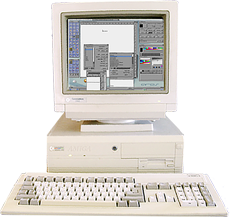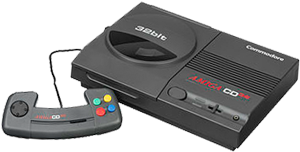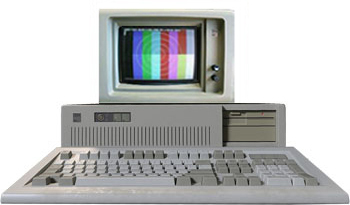Amiga 3000 — The Dream Machine of the Early ’90s
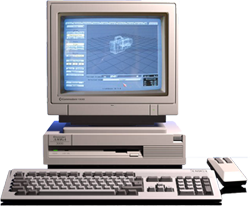
Released in 1990, the Commodore Amiga 3000 was a high-end, 32-bit business-class computer, powered by the Motorola 68030 CPU and 68882 math co-processor. Featuring the Enhanced Chip Set (ECS), AmigaOS 2.0, and a built-in VGA display enhancer, the A3000 represented the pinnacle of the Amiga line before the arrival of the AGA chipset. Fully backward-compatible with earlier Amiga systems, A3000 quickly became the dream system for dedicated users, with the notable exception that it could not run AGA software.
- Initially priced at $3,379 (roughly $7,500 in 2023 money)
- Only around 30,000 desktop units and 8,000 A3000T tower versions were ever produced, making it a relatively rare and sought-after model
![]() AMIGA 3000 AT A GLANCE
AMIGA 3000 AT A GLANCE
- CPU: Motorola 68030 with 68882 FPU
- Architecture: True 32-bit system with 32-bit memory bus
- Memory: 2 MB RAM (1 MB Chip RAM + 1 MB Fast RAM)
- ROM: 512 KB Kickstart
- Graphics: ECS (12-bit color palette, 4,096 colors)
- Video: Built-in display enhancer supporting VGA output
- OS: AmigaOS 2.0 (also supports 1.3)
- Storage: Internal SCSI-II controller, 40–100 MB hard drive
- Expansion: 4 × Zorro III slots (32-bit)
 Graphics & Display Modes
Graphics & Display Modes
With its integrated VGA display enhancer, the A3000 was the only Amiga model natively supporting VGA monitors. ECS chipset capabilities include:
- 1,280 × 512 resolution (up to 4 colors)
- 640 × 512 resolution (up to 16 colors)
- 320 × 512 resolution (up to 32 colors; up to 4,096 in HAM mode)
- Further enhancements are possible via Zorro III graphics cards (e.g., Picasso IV, ZZ9000)
![]() Audio Capabilities
Audio Capabilities
The Amiga 3000 retains the signature audio features of earlier models:
- 4-channel stereo sound (2 stereo pairs, 8-bit PCM)
- Sampling rates: 28 kHz (standard), up to 57 kHz
- Independent volume control (65 levels)
- Software-controlled low-pass filter
- Expandable with audio cards (e.g., Prisma Megamix, SunRize 1012, ZZ9000AX)
 Connectivity & I/O Ports
Connectivity & I/O Ports
- 2 × DE-9 ports (mouse/joystick)
- 25-pin RS-232 serial port
- 25-pin Centronics parallel port
- DB-23 RGB (for Amiga monitors)
- DB-15 VGA (standard PC monitors)
- RCA stereo audio out
- 5-pin DIN keyboard port
- DB-25 external SCSI connector
- 4 × internal Zorro III slots
 Monitor Compatibility
Monitor Compatibility
- Commodore monitors (e.g., 1084, 1942)
- Standard VGA monitors
- TVs via SCART
- HDMI monitors (with VGA-to-HDMI adapter)
 Expansions & Upgrades
Expansions & Upgrades
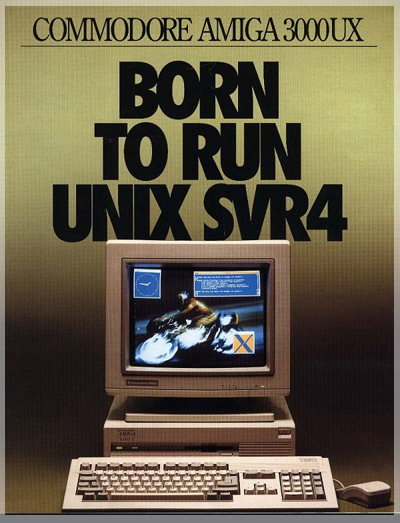 CPU: 68040, 68060, or PowerPC accelerator cards
CPU: 68040, 68060, or PowerPC accelerator cards- RAM: Up to 2 MB Chip RAM, 16 MB onboard Fast RAM, and up to 2 GB via Zorro III
- Storage: ZIP drives, internal Gotek drives
- Graphics: Picasso IV, ZZ9000, and more
- Audio: Expansion cards for professional sound output
- Networking: Ethernet expansion cards
- PC Emulation: On-board IBM PC-compatible hardware (286/386/486)
- Video: VT4000 (Video Toaster, redesigned for the A3000)
 Related Amiga 3000 Models
Related Amiga 3000 Models
• A3000+ (Prototype — Cancelled)
Planned upgrade featuring AGA graphics and an AT&T DSP3210 chip. Cancelled in 1991 and replaced by the Amiga 4000, which omitted DSP support but introduced AGA and a faster CPU.
• A3000UX (UNIX Edition)
A variant of the A3000 bundled with AT&T UNIX System V, targeting workstation users.
• A3000T (Tower Version)
Priced around $5,000, the A3000T was based on the desktop model but offered greater internal expandability. Early units featured the 68030, while later versions shipped with the 68040 and even third-party PowerPC processors.
■ Amiga 3000
BinaryValue.com (c)
Sources:
- Wikipedia
- Big Book of Amiga Hardware (bigbookofamigahardware.com)














 TOP-10 APPS
TOP-10 APPS